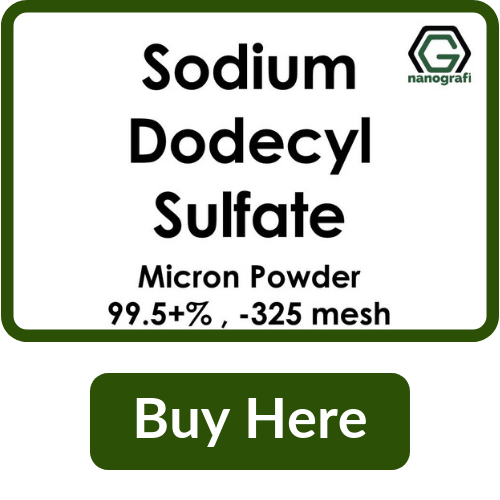Sodium dodecyl sulfate is a synthetic organic compound with the chemical formula of CH3(CH2)11SO4Na. Sodium dodecyl sulfate is an anionic surfactant used in many cleaning and hygiene products. Sodium dodecyl sulfate consists of a 12-carbon tail attached to a sulfate group, that is, it is the sodium salt of dodecyl hydrogen sulfate, the ester of dodecyl alcohol and sulfuric acid.
Hydrocarbon tail of sodium dodecyl sulfate combined with a polar "headgroup" give the compound amphiphilic properties and so make it useful as a detergent. Also derived as a component of mixtures produced from inexpensive coconut and palm oils, sodium dodecyl sulfate is a common component of many domestic cleaning, personal hygiene and cosmetic, pharmaceutical, and food products, as well as of industrial and commercial cleaning and product formulations.
The usage areas of sodium dodecyl sulfate is not limited by just these applications and products. As we all know graphene and carbon nanotubes are new generation materials used for many purposes and the scientists use these products in their researches. For example graphene is one of allotropic modifications of carbon element. Graphene’s structure is basically composed of monolayer carbon atoms hexagonal lattice, in which individual carbon atoms are connected by sp2 bonds, similar to those of nanotubes.
Recent researches have shown that the graphene and carbon nanotube based materials can have a deep impact on electronic and optoelectronic devices, chemical sensors, nanocomposites and energy storage. But because of van Der Waals forces between the carbon atoms in both graphene and carbon nanotubes, in some studies they are needed to be dispersed in aqueous medium.
Sodium dodecyl sulfate is one of the best choices to disperse graphene and carbon nanotubes. By using sodium dodecyl sulfate, graphene and carbon nanotubes can be dispersed in aqueous medium and can be used in different applications. For example, surface functionalized graphene obtained by dispersing them in aqueous medium has a number of superior advantages for biomedical applications, in particular, manufacturing of attachments for polymer molecules, creating of novel biosurface with graphene, as reinforcement for biopolymer coatings such as ultra-high molecular weight polypropylene, metallic biomaterials and bioceramics as hydroxyapatite. Surface modification of graphene by sodium dodecyl sulfate surfactant positively improves the attachment of polymer molecules for creating of novel biosurface with graphene.
It is also known that surface modification of graphene reduces its toxicity. We should mention that sodium dodecyl sulfate is not a carcinogenic chemical. So you may use it without any hesitation.
You may reach out more detailed information about usage of sodium dodecyl sulfate as surfactant for graphene and carbon nanotubes by clicking the links given below:
Read more about Sodium Dodecyl Sulfate:
A Very Convenient Surfactant for Scientific Researches: Sodium Dodecyl Sulfate
If you need sodium dodecyl sulfate for your research, you may visit our website and give an order of this chemical:


Comments
Post a Comment